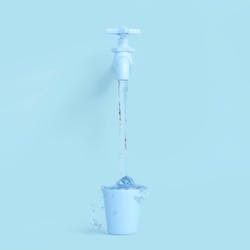It is estimated that nearly 60 million people in the United States were exposed to high levels of nitrate in their drinking water between 2017 and 2019. This article examines the origin and health effects of nitrate and discusses the best ways to remove this chemical from your water supply.
What Is Nitrate?
Nitrate is a nitrogen-based compound that is found in fertilizers, liquid waste and manure. Nitrogen in soil also converts into nitrate in the presence of natural bacteria. Almost all nitrates are soluble in water.
How Does Nitrate Get into Water?
Nitrate typically gets into water through surface runoff or leakage from wastewater, landfills, fertilized soil, urban drainage or septic systems.
Once nitrate gets into lakes, rivers and groundwater in a region, it can potentially make its way into water treatment plants. Some nitrate may be removed when water is processed for drinking, but this chemical is not eliminated.
Nitrate is particularly common in well water. Private well supplies are not treated by local authorities, so the well owner is responsible for testing for and removing this chemical from their water.
Nitrate in Food
Nitrate is not only a problem in water; it is also naturally found in some dairy products, vegetables and meat. Nitrates are found naturally in the soils that grow fruits and vegetables and are often used in fertilizers. Additionally, nitrates are added to cured meat products to extend their lifespan.
Eating a lot of vegetables, cured meats and dairy products will further contribute to a person’s daily nitrate intake.
Health Concerns of Drinking Nitrate
According to a 2018 review, nitrogen interferes with the blood’s oxygen-carrying capability, causing or increasing the risk of:
- Methemoglobinemia, or blue baby syndrome, a life-threatening condition that causes the skin to turn a blue-ish color and reduces blood pressure, causes headaches and stomach cramps and increases heart rate.
- Adverse pregnancy outcomes due to drinking nitrate-contaminated water during pregnancy, increasing the risk of low birth rate, fetal deaths, premature birth, spontaneous abortion, and congenital malformations.
- Cancer, especially gastric cancer, bladder cancer, breast cancer and colorectal cancer.
- Thyroid disease, due to a high intake of nitrogen inhibiting iodine uptake and inducing hypertrophy of the thyroid gland.
- Other health concerns, including high blood pressure, headaches, Type 1 Diabetes in children, anemia, lung disease, nausea and abdominal cramps.
- Does Nitrate Have Health Benefits?
- There are several potential benefits of nitrate ingestion, including:
- Lowering of blood pressure;
- Immunoregulatory effects;
- Increased blood flow in certain parts of the brain; and
- Preventative effects on inflammatory bowel disease.
- These potential health benefits are based on small studies, and what we know so far suggests that the health risks of nitrate outweigh its potential benefits.
How Much Nitrate is Safe in Water?
The U.S. EPA has set a Maximum Contaminant Level of 10 mg/L of nitrate in drinking water.
However, many organizations argue that the EPA’s Maximum Contaminant Level is too lenient and that nitrate may cause harm even in these trace amounts.
The Environmental Working Group (EWG) is one of these organizations and sets a Health Guideline of 0.14 ppm for nitrate in drinking water, almost 10% of the EPA’s MCL. This, according to the EWG, is to protect against harm to fetal development and cancer.
How to Test for Nitrate in Water
The most affordable way to test for nitrate in water is to use a water quality test kit, available for less than $20 online.
The kit will provide instructions for testing water. Usually, these steps will involve taking a sample of water and dipping a test strip into the sample. Then, the test strip can be compared to a color chart that indicates what the water contains.
Alternatively, consider private testing from a state-certified laboratory. This method of testing is more expensive – costing $100 or more – but it provides a much more detailed analysis of the water quality.
How to Remove Nitrate from Water
To remove nitrate from water, the following water treatment methods are commonly used.
Reverse Osmosis
Reverse osmosis is the most effective way to remove nitrate. RO membranes contain tiny pores that trap contaminants like nitrate, allowing only pure water to pass through.
Reverse osmosis can remove more than 99.99% of nitrate, but this method has a downside – it is expensive and wastes water, so it is rarely used for large-scale treatment.
Distillation
Distillation is another highly effective water purification process that reduces nitrate. Distillers boil water until it evaporates, then transport the water vapor into a clean container, leaving the contaminants behind.
The distillation method produces clean, pure water, but it takes up to five hours to distill a single batch of water.
Ion Exchange
Ion exchange resin removes nitrate by exchanging this chemical with chloride ions. This process is the same process that is used to remove hardness minerals in a common water softener.
Ion exchange is the best nitrate removal solution for large-scale applications.
Takeaway
Nitrate is a dangerous chemical with concerning health effects, especially for pregnant women, babies and infants. Nitrate gets into water through surface runoff. While the U.S. EPA has set an MCL of 10 mg/L for nitrate in drinking water, many organizations believe that this limit should be lower.
One can test for nitrate in water using an at-home test kit or a laboratory test. The best water treatment methods to remove nitrate are reverse osmosis, distillation and ion exchange resin.
